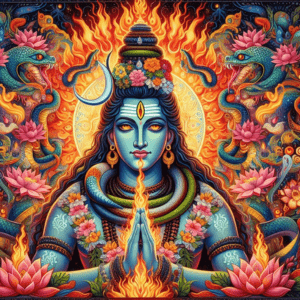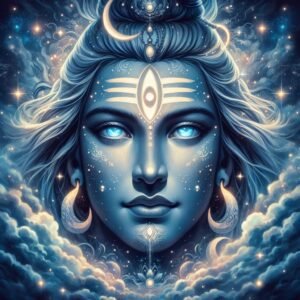The Mystical Third Eye of Lord Shiva: Unveiling Hidden Wisdom

In Hindu mythology, Lord Shiva is revered as one of the principal deities representing transformation, destruction and spiritual awakening. Among the many fascinating aspects of Lord Shiva’s persona, his third eye, positioned prominently on his forehead, holds a particularly intriguing place. This divine eye, also known as the Ajna Chakra, transcends the physical realm, revealing deeper truths and hidden dimensions. In this blog post, we delve into the multifaceted symbolism, mythology, yogic essence and significance of Lord Shiva’s third eye and its relevance in Hindu culture and spirituality.
The Power of Perception: Beyond the Physical Realm
Unlike his two physical eyes, which perceive the external world, Shiva’s third eye represents inner vision. It symbolizes wisdom, insight, and the ability to see beyond the limitations of the material world. It delves into the depths of our consciousness, granting us access to intuition, clairvoyance, and a deeper understanding of reality.
Fire and Destruction: A Force for Transformation
The third eye is often depicted as a fiery eye, capable of immense destructive power. This fire doesn’t represent blind annihilation, but rather a transformative force. It burns away ignorance, illusions, and negative desires that cloud our judgment. This destruction is a necessary precursor for creation, paving the way for spiritual growth and enlightenment.
Mythological Significance
Story of Annihilating the Demon
The origin story of Lord Shiva’s third eye is steeped in myth and legend. According to Hindu scriptures, during a fierce battle between Lord Shiva and the demon Tripura, the intensity of Shiva’s meditation and concentration reached such heights that a third eye emerged on his forehead. This eye unleashed a powerful beam of fire, annihilating the demon and restoring balance to the universe. The third eye thus symbolizes Shiva’s inner fire and his ability to destroy ignorance and evil forces.
Story of Self-Mastery: The Taming of Kamadeva
A popular story associated with Shiva’s third eye involves Kamadeva, the god of love and desire. When Kama attempted to disrupt Shiva’s meditation with a flower arrow, Shiva opened his third eye, reducing Kama to ashes. This incident symbolizes the taming of desires and the importance of self-control on the path to spiritual liberation.

Cultural Depictions of Third Eye of Lord Shiva: Witnessing the Past, Present, and Future
Lord Shiva’s third eye is a popular motif in Hindu art and iconography. It is depicted as a vertical eye with flames emanating from it, symbolizing divine knowledge and destruction of ignorance. Various sculptures and paintings depict Shiva with his third eye open, signifying his omnipotence and divine power. Additionally, festivals such as Maha Shivaratri celebrate the significance of Lord Shiva’s third eye through rituals and prayers.
The third eye is believed to possess the power to see beyond the constraints of time. It perceives not just the present moment, but also the past, present, and future. This omniscience allows Shiva to maintain cosmic balance and intervene when necessary. On an individual level, it signifies the ability to learn from the past, live fully in the present, and make informed choices for the future.
Spiritual Interpretations of Third Eye : The Ajna Chakra: Aligning with the Divine
In Hinduism, the third eye holds deep spiritual significance. It is believed to be the center of insight and intuition, providing seekers with the ability to perceive the true nature of reality. Through the awakening of the third eye, individuals can attain higher states of consciousness and achieve spiritual enlightenment. The third eye is often associated with the Ajna chakra, which is situated between the eyebrows. It is considered the seat of intuition, imagination, and higher consciousness. By awakening the Ajna Chakra through meditation and spiritual practices, one can cultivate inner wisdom, clarity of thought, and a heightened sense of self-awareness.
The Mark of the Auspicious: The Tilak and Third Eye Symbolism
The tilak, a dot worn on the forehead by Hindus, often finds its place between the eyebrows, mirroring the position of the third eye. This practice signifies the aspiration to cultivate the qualities associated with the third eye – wisdom, spiritual insight, and auspiciousness.
Beyond Hinduism: The Universal Relevance of the Third Eye of Lord Shiva
The concept of the third eye isn’t exclusive to Hinduism. Similar ideas exist across various cultures and spiritual traditions. The “all-seeing eye” found in Freemasonry and the “pineal gland” believed to be the seat of spiritual awakening in some religions all point towards a universal recognition of the potential for inner vision and higher consciousness.
Modern Relevance
In contemporary times, the concept of Lord Shiva’s third eye continues to captivate people’s imagination. It has found its way into popular culture, appearing in books, movies, and art forms. The symbolism of the third eye has also permeated the realm of yoga and meditation, where practitioners seek to awaken their inner vision and tap into higher realms of consciousness. The third eye serves as a potent symbol of inner transformation and self-realization.
Unveiling Your Own Third Eye: A Path to Self-Discovery

While Shiva’s third eye represents a powerful divine force, it also serves as a metaphor for the potential within each of us. By embracing meditation, mindfulness practices, and introspection, we can cultivate our own inner vision and unlock the wisdom that lies dormant within.
The journey to awaken the third eye is a lifelong pursuit, filled with challenges and rewards. It’s a path of self-discovery, leading to a deeper understanding of ourselves and the universe around us.
Conclusion
Lord Shiva’s third eye is a powerful symbol that transcends mere physical representation. It embodies the eternal struggle between light and darkness, knowledge and ignorance and the pursuit of wisdom, self-mastery, and enlightenment. By exploring the mythological, spiritual, cultural dimensions and multifaceted interpretations of the third eye, we gain valuable insights not only about Lord Shiva but also about ourselves and our own potential for spiritual growth. May the symbolism of the third eye inspire us to seek enlightenment and embrace the divine within.
Frequently Asked Questions
- What is the significance of the third eye of Lord Shiva in Hinduism?
Lord Shiva’s third eye symbolizes his divine power and ability to destroy ignorance and evil forces. It represents inner fire, intuition, and insight, leading seekers towards spiritual enlightenment.
- How does the concept of the third eye relate to meditation practices?
In meditation practices, the third eye is associated with the Ajna chakra, located between the eyebrows. By focusing on this area during meditation, practitioners aim to awaken their inner vision and tap into higher states of consciousness.
- Are there any scientific interpretations of the third eye of Lord Shiva?
While Lord Shiva’s third eye is primarily a symbolic and mythological concept in Hinduism, some individuals interpret it metaphorically as the pineal gland in the brain, which is associated with spiritual experiences and consciousness.
- What role does the third eye of Lord Shiva play in Hindu festivals?
Lord Shiva’s third eye is celebrated during festivals such as Maha Shivaratri, where devotees offer prayers and perform rituals to honor Shiva’s divine attributes, including his third eye. It serves as a symbol of spiritual awakening and transformation.
- How can one awaken their inner vision, akin to the third eye of Lord Shiva?
Awakening the inner vision requires dedicated spiritual practice, such as meditation, yoga, and self-reflection. By cultivating mindfulness and inner awareness, individuals can gradually open up their intuition and connect with higher realms of consciousness, similar to the symbolism of Lord Shiva’s third eye.


1 thought on “The Mystical Third Eye of Lord Shiva: Unveiling Hidden Wisdom”